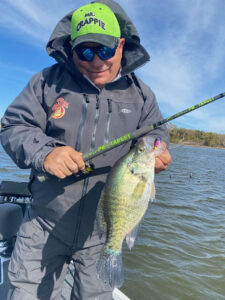By Bob Jensen
Fishing the Midwest Fishing Team

(photo by Bob Jensen) Even when the water is cold, crappies eat plastic baits.
It was about this time of year ten years ago when a friend and I made a plan to go fishing. Walleyes would be the target. We would meet at the boat ramp. I asked if I should pick up some minnows.
My friend said that I could if I wanted to, but we probably wouldn’t need them. Since minnows had always been a big part of my walleye chasing, and since I resist change, I picked up a couple dozen minnows.
When we met at the lake, I asked what the plan was. My fishing partner said that we would be using jigs tipped with plastic tails. I had used plastic for walleyes in the past with success, but always when the water was warmer. On this day, again because I resist change, I started with a jig/minnow. My boat-mate went with the jig/plastic combo. My boat-mate caught more walleyes than I did.
At the time, the conventional fishing wisdom was that plastic was good in the summer months, but not so good in the cold waters of the fall and winter seasons. After an afternoon of fishing, I once again learned that conventional fishing wisdom is not always wise. Since that day, plastic tails on jigs have become a big part of my autumn and early winter open water fishing. Rage Swimmers have fooled lots of walleyes into biting, and Mr. Crappie Shadpoles have become the bait of choice for anglers looking for crappies and perch in cold water.
A few years later, I made plans to go ice fishing with another friend. Same thing: Friend says we don’t need live bait. We’ll use plastic. Again, same thing: I still resist change, so I brought minnows and waxworms along.
My friend caught more fish than I did. His hands stayed warm because he didn’t need to handle cold, wet minnows, and he had less stuff to carry as we moved from hole to hole. Since that day, plastic tails on jigs have become a big part of my ice fishing adventures.
Maki plastics are extremely soft baits, so they wiggle with just the slightest rod motion. And, although they’re very soft, they’re quite durable. You’ll generally catch several fish on one bait. Maki Baits have become the go-to for many of the most successful ice anglers.
There are several reasons why many successful anglers prefer to use plastic tails instead of live bait in open water or through the ice. Most of those reasons have to do with convenience. In some areas, live bait, minnows in particular, can be hard to find. In other places there are restrictions on where minnows can be used and how they can be transported.
Color can be a very important consideration when it comes to catching fish, and this is a factor that really shines when using plastic. Plastic baits are available in virtually any color that an angler could want. It works well to use a jig head of one color with a tail of another color. By doing so, we’re showing the fish two different colors and increasing the odds of showing the fish the color that they are most likely to eat at that time.
My experiences with plastic baits and my resistance to use them in cold water have taught me two very important things when it comes to fishing success. Plastic baits catch fish year ‘round, and I need to quit being so resistant to change.



















